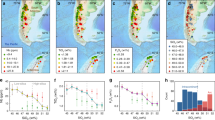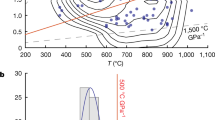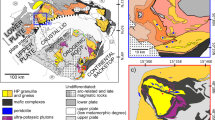Abstract
The timing of onset of modern-style plate tectonics is debated. The apparent lack of blueschist metamorphism1—a key indicator of modern plate subduction2—in rocks aged more than about 1 billion years calls into question the existence of plate tectonics during the Archaean and Palaeoproterozoic eras3,4. Instead, plate tectonics and subduction could have either not occurred at that time5, or could have proceeded differently6 owing to warmer conditions in the early Earth mantle7. Here we use thermodynamic models8,9,10 to investigate the formation conditions of metamorphic minerals in the 2.2–2.0 Gyr old West African metamorphic province. We find a record of blueschist metamorphism in these rocks. We show that minerals such as chlorite and phengite formed at high pressures of 10–12 kbar, low temperatures of 400–450 °C and under a geothermal gradient of 10–12 °C km−1. These conditions are typical of modern subduction zones. We therefore suggest that modern-style plate tectonics existed during the Palaeoproterozoic era. We conclude that ancient blueschist metamorphism may exist in other parts of the world, but the identification of these rocks has so far been hampered by methodological problems associated with deciphering their pressure and temperature evolution.
This is a preview of subscription content, access via your institution
Access options
Subscribe to this journal
Receive 12 print issues and online access
$259.00 per year
only $21.58 per issue
Buy this article
- Purchase on Springer Link
- Instant access to full article PDF
Prices may be subject to local taxes which are calculated during checkout




Similar content being viewed by others
References
Maruyama, S., Liou, J. G. & Terabayashi, M. Blueschists and eclogites of the world and their exhumation. Int. Geol. Rev. 38, 485–594 (1996).
Stern, R. J. Evidence from ophiolites, blueschists, and ultrahigh-pressure metamorphic terranes that the modern episode of subduction tectonics began in Neoproterozoic time. Geology 33, 557–560 (2005).
Cawood, P. A., Kröner, A. & Pisarevsky, S. Precambrian plate tectonics: Criteria and evidence. GSA Today 16, 4–11 (2006).
De Wit, M. J. On Archean granites, greenstones, cratons and tectonics: Does the evidence demand a verdict? Precambr. Res. 91, 181–226 (1998).
Hamilton, W. B. Archean magmatism and deformation were not products of plate tectonics. Precambr. Res. 91, 143–179 (1998).
Davies, G. F. On the emergence of plate tectonics. Geology 20, 963–966 (1992).
Bjørnerud, M. G. & Austrheim, H. Inhibited eclogite formation: The key to the rapid growth of strong and buoyant Archean continental crust. Geology 32, 765–768 (2004).
De Andrade, V., Vidal, O., Lewin, E., O’Brien, P. & Agard, P. Quantification of electron microprobe compositional maps of rock thin sections: An optimized method and examples. J. Metamorph. Geol. 24, 655–668 (2006).
Vidal, O. et al. P–T-deformation-Fe3+/Fe2+ mapping at the thin section scale and comparison with XANES mapping. Application to a garnet-bearing metapelite from the Sambagawa metamorphic belt (Japan). J. Metamorph. Geol. 24, 669–683 (2006).
Yamato, P. et al. New, high-precision P–T estimates for Oman blueschists: Implications for obduction, nappe stacking and exhumation processes. J. Metamorph. Geol. 25, 657–682 (2007).
Perchuk, L. L. et al. Comparative petrology and metamorphic evolution of the Limpopo (South Africa) and Lapland (Fennoscandia) high-grade terrains. Mineral. Petrol. 69, 69–107 (2000).
Vidal, O., Parra, T. & Trotet, F. A thermodynamic model for Fe–Mg aluminous chlorite using data from phase equilibrium experiments and natural pelitic assemblages in the 100–600 °C, 1-25 kbar P–T range. Am. J. Sci. 301, 557–592 (2001).
Parra, T., Vidal, O. & Agard, P. A Thermodynamic model for Fe–Mg dioctahedral K-white micas using data from phase equilibrium experiments and natural pelitic assemblages. Contrib. Mineral. Petrol. 143, 706–732 (2002).
Dubacq, B., Vidal, O. & De Andrade, V. Dehydration of dioctahedral aluminous phyllosilicates: Thermodynamic modelling and implications for thermobarometric estimates. Contrib. Mineral. Petrol. 159, 159–174 (2010).
Baratoux, L. et al. Juvenile Paleoproterozoic crust evolution during the Eburnean orogeny (∼2.2–2.0 Gyr), western Burkina Faso. Precambr. Res. 191, 18–45 (2011).
Doumbia, S. et al. Petrogenesis of juvenile-type Birimian (Paleoproterozoic) granitoids in Central Côte-d’Ivoire, west Africa: Geochemistry and geochronology. Precambr. Res. 87, 33–63 (1998).
Dioh, E., Béziat, D., Debat, P., Grégoire, M. & Ngom, M. Diversity of the Paleoproterozoic granitoids of the Kédougou inlier (eastern Sénégal): Petrographical and geochemical constraints. J. Afr. Earth Sci. 44, 351–371 (2006).
Bonhomme, M. Contribution à l’étude géochronologique de la plate-forme de l’Ouest Africain. Ann. Fac. Sci. Univ. Clermont-Ferrand 5 (1962).
Feybesse, J-L. et al. The paleoproterozoic Ghanaian province: Geodynamic model and ore controls, including regional stress modelling. Precambr. Res. 149, 149–196 (2006).
Vegas, N., Naba, S., Bouchez, J-L. & Jessell, M. Structure and emplacement of granite plutons in the Paleoproterozoic crust of Eastern Burkina Faso: Rheological implications. Int. J. Earth Sci. 97, 1165–1180 (2007).
Berman, R. G. Thermobarometry using multi-equilibrium calculations: A new technique, with petrological applications. Can. Mineral. 29, 833–855 (1991).
Powell, R. & Holland, T. J. B. Optimal geothermometry and geobarometry. Am. Mineral. 79, 120–133 (1994).
Connolly, J. A. D. The geodynamic equation of state: What and how. Geochem. Geophys. Geosyst. 10, q10014 (2009).
Moyen, J-F., Stevens, G. & Kisters, A. Record of mid-Archaean subduction from metamorphism in the Barberton terrain, South Africa. Nature 442, 559–562 (2006).
Mints, M. V. et al. Mesoarchean subduction processes: 2.87 Ga eclogites from the Kola Peninsula, Russia. Geology 38, 739–742 (2010).
Möller, A., Appel, P., Mezger, K. & Schenk, V. Evidence for a 2 Ga subduction zone: Eclogites in the Usagaran belt of Tanzania. Geology 23, 1067–1070 (1995).
Condie, K. C & Kröner, A. in When Did Plate Tectonics Begin on Planet Earth? Vol. 440 (eds Condie, K. C. & Pease, V.) 281–294 (GSA, 2008) (special issue).
Brown, M. D. in When Did Plate Tectonics Begin on Planet Earth? Vol. 440 (eds Condie, K. C. & Pease, V.) 97–128 (GSA, 2008) (special issue).
Ernst, W.G. Archean plate tectonics, rise of Proterozoic supercontinentality and onset of regional, episodic stagnant-lid behaviour. Gondwana Res. 15, 243–253 (2009).
Vidal, O. & Parra, T. Exhumation paths of high pressure metapelites obtained from local equilibria for chlorite–phengite assemblages. Geol. J. 35, 139–161 (2000).
Acknowledgements
The project was financially supported by IRD and INSU-CNRS. We thank the ID21 beamline staff at the ESRF for providing us with beam time that supported our calculations by in situ measurements. We also acknowledge the team of the AMIRA P934 project for logistic support in Burkina Faso. B. Goscombe, D. Chardon and J.-L. Bouchez are thanked for comments and discussions.
Author information
Authors and Affiliations
Contributions
J.G. conceived the study and wrote the paper. V.D.A. and J.G. contributed equally to the petrologic analysis and metamorphic modelling. R.F.W. and V.D.A. helped generate the research idea with J.G. and contributed to the writing and focusing of the paper. B.D. and O.V. provided the most updated solid-solution models for chlorite and phengite. All authors contributed to the interpretation of these results within the greenstone belts of the WAC.
Corresponding author
Ethics declarations
Competing interests
The authors declare no competing financial interests.
Supplementary information
Supplementary Information
Supplementary Information (PDF 5148 kb)
Supplementary Information
Supplementary Information (XLS 110 kb)
Rights and permissions
About this article
Cite this article
Ganne, J., De Andrade, V., Weinberg, R. et al. Modern-style plate subduction preserved in the Palaeoproterozoic West African craton. Nature Geosci 5, 60–65 (2012). https://doi.org/10.1038/ngeo1321
Received:
Accepted:
Published:
Issue Date:
DOI: https://doi.org/10.1038/ngeo1321
This article is cited by
-
Insights from mineral trace chemistry on the origin of NYF and mixed LCT + NYF pegmatites and their mineralization at Mangodara, SW Burkina Faso
Mineralium Deposita (2023)
-
Chemical and boron isotope composition of tourmaline from the Kiaka orogenic gold deposit (Burkina Faso, West African Craton) as a proxy for ore-forming processes
Mineralium Deposita (2022)
-
Paleoproterozoic gold events in the southern West African Craton: review and synopsis
Mineralium Deposita (2022)
-
The stability of subducted glaucophane with the Earth’s secular cooling
Nature Communications (2021)
-
Continuous plate subduction marked by the rise of alkali magmatism 2.1 billion years ago
Nature Communications (2019)



